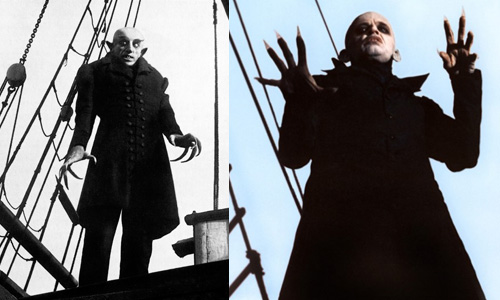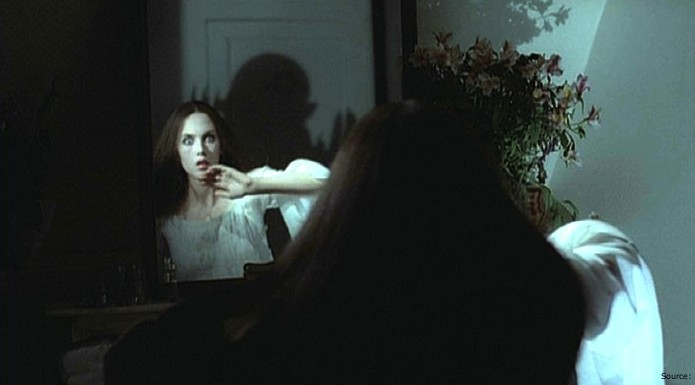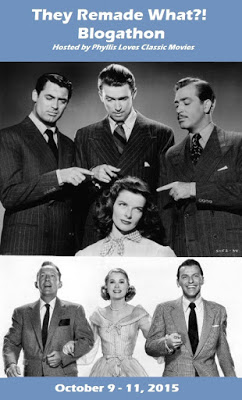To be unable to grow old is terrible… Death is not the worst… Can you imagine enduring centuries, experiencing each day the same futilities…
My favorite vampire film of all time happens to be an homage to film history’s most significant vampire film of all time. You could call it a remake, but the word doesn’t fit…”homage” is far more appropriate. And to use another appropriate word, it’s deeply haunting: Werner Herzog’s Nosferatu: Phantom der Nacht (1979).

Many film fans, used to straightforward classic horror like The Phantom of the Opera (1925) and Frankenstein (1931), will find that Herzog’s Nosferatu inhabits a different plane. It has all the same characters–Jonathan Harker, Lucy, Renfield, Count Dracula–and the same plot created by Bram Stoker (it’s indebted to the novel). But it’s not interested in the formulaic. It lingers. It establishes mood. It meditates over shots of cold rocky mountains, of a deserted ship adrift in a canal, of a weed tuft quivering in a breeze seeping through a broken castle window…

If you’re familiar with Herzog’s unusual work, you already know his use of long, contemplative shots and documentary-like style. Aguirre, the Wrath of God (1972) might be his most famous film, about an expedition of 16th century conquistadors searching for El Dorado in remote areas of the Amazon. He favors tales of obsession, grand themes, eccentrics, and isolated people. He craves realism, taking his crew to remote, even dangerous areas for the “voodoo of the location.” Certain images and ideas recur throughout his films–even certain noises. In Nosferatu one of his favorite sounds makes a cameo: music from a scratchy, slightly out-of-tune violin.
When Herzog decided to make Nosferatu: Phantom der Nacht, it was out of awe of F.W. Murnau’s original. He’s stated that in his opinion the 1922 Nosferatu is the greatest German film ever made.

And thus, we have a vampire film that seems unaware of the existence of suave, Lugosi-esque predators and other Hollywood clichés. Star Klaus Kinski dons the bat ears and rodent fangs based on Max Schreck’s makeup (as far as I know, Kinski was the only other actor to use that particular look). We have several of the same locations Murnau used in his film, and a few shots that mirror his most iconic moments. And we also have a strong dose of what made the 1922 film so great: the atmosphere of creeping, unsettling, supernatural evil.

“Death is not the worst. There are things more horrible than death,” Count Dracula tells Jonathan (Bruno Ganz) as they dine in his chilly hall–or, rather, as Jonathan dines while Dracula quietly, intently watches him. Herzog’s Count, like Murnau’s, is a being cursed to a terrible, endless fate, one that he laments matter-of-factly but cannot escape. His hunger for blood is like the primal hunger of an animal–vile and ugly the hunger may be, but he must be satiated.
Dracula’s granted some complexity in his interactions with the ethereal Lucy (played with a mystical air by Isabelle Adjani). She is his prey, but something about her prompts him to reach out: “Will you come to me, become my ally? Bring salvation to your husband, and to me. The absence of love is the most abject pain.” He is rejected, of course, but must’ve known that he would be.

This nod of complexity carries through the ritualistic sequence where Lucy sacrifices herself in order to end Dracula’s pestilence. She lays on the bed nervously, but is completely resolute, guiding the vampire’s face to her neck herself. In a nod to the eroticism that’s often entwined with vampire legends today, Dracula, looking over his victim, gently moves her dress to caress her thigh, as if trying to remember the feel of a willing lover. It’s not gratuitous; it signifies not only Lucy’s consent to be a victim but serves as a reminder of Dracula’s curse–enduring centuries of being cut off from love and human affection.
Herzog’s Count Dracula wouldn’t have been so powerful if not for Klaus Kinski. One of the most intense actors of his time, Kinski was arguably one of the most difficult actors that ever worked in the movies. He was prone to explosive rages and demanding behavior on set; his rants, which could last for hours, are legendary. But he throws himself into the role of the Count, making him both frighteningly unpredictable and somehow forlorn. He came very close to matching Max Schreck’s iconic Orlok.

Nosferatu: Phantom der Nacht feels, above all, authentic–shots capture the real locations and real weather. There are very few constructed sets, or perhaps there were none at all. Part of its realism lies in the unexpected, such as the startling opening with closeups of real mummified human bodies (shot at the Museo de las Mumias) and the “Danse Macabre” scene in the town square, which becomes crawling with thousands of rats (dyed gray for the film). Dracula’s castle is not the crumbling, ornate gothic building we normally see, but a real castle in the Czech Republic with thick white walls and minimalist architecture. The only music is the ambient soundtrack by Popul Vuh. Much of the time, we only hear natural sound, as if we were standing in the film’s locations ourselves hearing every footstep and those far-off, howling wolves.

Herzog would be the first one to agree that “homage” or “tribute” are the more suitable words for his film. He even stated, “I should caution you: it’s not a remake.” It is, perhaps, a meditation on Murnau’s epochal film, which itself addresses the very heart of the vampire legend. In that legend there are no suave ladykillers, no screaming teenagers, no jump scares, no gallon of corn syrup blood. There is only the pure, gothic horror that resides in our collective subconscious.

—
Extra tidbits:
- There are both German and English speaking versions, the English version being called Nosferatu the Vampyre. I demand that you see the German version, since the language and subtitles add a great deal to the overall atmosphere.
- While the film still goes by the name Nosferatu, it uses the names from Bram Stoker’s novel. This is because the copyright to Stoker’s work had run out by that time–which was not the case with Murnau’s 1922 Nosferatu.
- Herzog could be fanatical about getting just the right setting and effects for his film. The thousands of rats plaguing the town (around 11,000) had to be dyed gray, a process which was said to have killed around half of them.
- Of Kinski’s behavior during the filming, Herzog said that the rats behaved better than he did.
- Nevertheless, Kinski did endure four hours of makeup application a day without complaint.
I’ve been wanting to salute this film around Halloweentime almost the moment I started Silent-ology back in 2014. Having it tie into Phyllis’s They Remade What?! blogathon is a delightful stroke of fate.

Thank you for stopping by, blogathon readers, and I hope you enjoyed my thoughts on this incredible film. Now go check out all those other fine entries!

I always thought this film looked gorgeous. I need to nab it!
It really is, and it’s perfect to watch around Halloween. This film is actually in my Top 10 Favorite Films Ever list–no joke!
What do you think of “Shadow of the Vampire” .
You know, I’ve never seen it! But just added it to my Netflix queue, thanks to your comment. 🙂
Okay, I have only seen the English version, and I gleefully accept your demands, because I too have noticed that Vampire stories are much more intense in German! Great coverage of a fantastic film!
Something about the German language goes with the Gothic atmosphere remarkably well. No wonder so many dark fairytales and legends came from Germany. And thank you very much!
I’m a big Herzog fan and this is one of my favorite films. Such great atmosphere and probably Kinski’s best performance.
It’s a work of genius. Oh yes, this is definitely one of my top picks for Kinski’s best performance. The other contender I’d give would be his acting in Woyzeck. Interestingly enough, Woyzeck was filmed only a few days after Nosferatu was finished, and arguably Kinski’s acting wouldn’t have been the same if wasn’t still “haunted” by his Count Dracula, if that makes any sense.
As a remake, it compares poorly, but as a homage… oh, my! Herzog really got the feeling of Murnau’s masterpiece, and of course Kinski is to be blamed for his near-perfect interpretation. The 1979 Nosferatu is, after all, a beautiful and thrilling tribute.
Don’t forget to read my contribution to the blogathon! 🙂
Kisses!
Le
http://www.criticaretro.blogspot.com
Thanks for stopping by! I see I’m not the only one who feels that Nosferatu is most certainly an homage, not really a “remake” (okay, aside from Herzog himself…).
Oh my gosh…..what’s so weird is I’m reading “Herzog On Herzog” right now!!!! I was reading it TODAY while I was on line to see the free screening of …….”The Mark Of Zorro” at Lincoln Center!!! AAAAAAAAH! Lea and Friends, I had such a great day! My friend loved it! The audience was cheering, applauding sequences and gave the film a standing ovation!!! I wish you could all have been there! Afterwards we walked through Central Park for hours, talking about the movie…..a perfect day!
But this is about Werner! I love Werner! I haven’t seen “Nosferatu” in years, I’ve been meaning to revisit it! I saw it BEFORE I was into Herzog, so I’m way overdue. I’ve also never seen “Hearts Of Glass” which I’m dying to see. Anyways, you really whet my appetite to see this again…..and I will! Even if it is one of those new “talking pictures” I keep hearing about!
(The rats were better behaved than Kinski, HA!!!!!)
Now that’s a big coincidence! 😀 Here’s another one for you: awhile ago I was on a Herzog binge, watching his films and reading interviews and articles about him like crazy. (I also go on occasional Keystone binges and 1920s avant-garde binges…anyhoo.) While online I happened upon an article about a new biography on Clyde Bruckman, one of Buster Keaton’s best gag men and an important guy in silent comedy. The quote that was on the front cover? FROM HERZOG, of all things. Never, ever thought I’d see the world of Werner and the world of Buster collide like that!
Yes, dust off that DVD and watch Nosferatu again! This is the perfect time of the year for it. In fact, I’m about to rewatch it again myself…
p.s. the Mark of Zorro film sounds like it was a blast! Ain’t nothin’ like a good standing ovation for someone like Doug.
Amen to that sister! (all the above)
I’m going upstate this weekend, where the leaves are falling and I’ll be in the middle of nowhere! That’s when I’ll rewatch it!!!!
That’s amazing about the Clyde Bruckman book! I was under the impression that Werner wasn’t such a cinefile that he’d care much about the silents! Of course, you don’t have to be a cinefile to adore Buster Keaton (you basically just need a pulse and working lungs!!!)
In this book I’m reading, Werner is talking about the very first film he ever made, when he was a kid, with his friends…..and that recently he’d seen Melies’ “The Dwarf and The Giant”, and was struck how similar it was to that first film Werner had made with his friends! He seemed proud that he was a sort of Junior Melies!
Lea, if you get a chance, email me at perrinyone@gmail.com. I have something to send you!
I don’t think of myself as much of a vampire fan in general, but last year I read the Stoker story for the first time and I’ve already watched three vampire movies this month! Must be something in the … wine. I haven’t seen “Nosferatu” in many years, but you have made the idea of Herzog’s film incredibly intriguing. You’ve drawn me in. Is it hypnotism?
Sssh, no one’s supposed to know that. 😛 I LOVE Stoker’s novel, it’s the kind of book that’s hard to put down. It’s very interesting to see what the original Count Dracula was like–an old man with a mustache, squat fingers, and bad breath! A far cry from today’s suave villains, isn’t he? Especially in this post-Twilight era.
Really a dream like film and I do love the cinema of Herzog and his flicks with Kinski. Well done on the homage angle that you’ve explored and I would also direct you to have some fun watching Shadow of the Vampire.
Thanks, and I will! I’ll have to share my thoughts on it, too.
“as far as I know, Kinski was the only other actor to use that particular look”
So, there are a couple of other homages to take into account here. The first, “Shadow of the Vampire,” was already mentioned above, and that includes Willem Dafoe’s turn under the makeup. Another one is the TV series “Kindred: The Embraced.” This series was based on the old live-action RPG “Vampire: The Masquerade,” which included an entire clan of vampires called “Nosferatu” and resulted in many young people mimicking Schreck’s makeup in private gatherings. The actor Jeff Kober mostly wore a toned-down version (which implied his use of an illusion to mask his true appearance), but there are a few scenes in which it is revealed.
I had a feeling someone would prove me wrong on that one… 😉 I’d forgotten about the one super obvious film, “Shadow of a Vampire.” The TV series I’ve never heard of, so that’s a nice tidbit.
Also, the vampire in Tobe Hooper’s TV movie adaptation of ‘Salem’s Lot:
https://gfycat.com/insidiousblankblackfly
I’m glad you were able to write this in time for Halloween! Thanks so much for participating!
You’re most welcome–and thank YOU for hosting!
Pingback: Presenting… | Silent-ology
Pingback: A Halloween Post Roundup! | Silent-ology
Reblogged this on Abraham's Vault.
Pingback: 6 Silent-Related Locations Still On My Bucket List | Silent-ology
Pingback: 12 Spooky Films I Watch Every October | Silent-ology
Pingback: Ask Me Anything!–Answers To Your Qs | Silent-ology
Pingback: A Century Of “Nosferatu” (1922) | Silent-ology